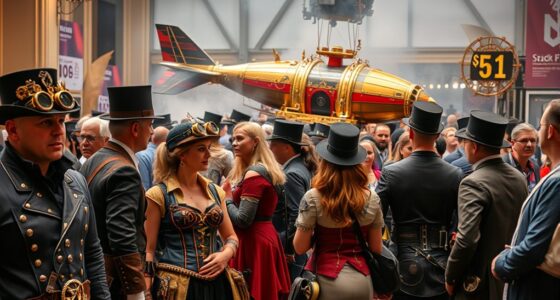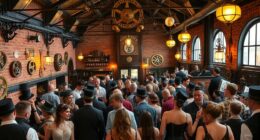Steampunk started as a literary movement inspired by Victorian science fiction, imagining futures powered by steam and clockwork. Over time, it grew into a vibrant subculture blending Victorian fashion, industrial aesthetics, and imaginative technology. Enthusiasts craft elaborate costumes, artwork, and stories that celebrate innovation and craftsmanship. If you want to explore how Victorian optimism evolved into a creative world of gears and gadgets, there’s much more to uncover below.
Key Takeaways
- Steampunk originated from Victorian-era literature imagining alternative futures with steam-powered technology.
- It evolved from Victorian innovations into a literary genre exploring “what if” scenarios of continued technological progress.
- The aesthetic combines Victorian fashion with industrial materials, emphasizing craftsmanship and intricate machinery.
- It transitioned from a literary concept to a broader subculture involving art, cosplay, and maker communities.
- Today, steampunk celebrates creative expression blending Victorian style with futuristic and fantastical inventions.

Have you ever wondered where steampunk’s unique blend of Victorian elegance and industrial innovation originated? It all begins with Victorian innovations, a period marked by rapid technological progress and groundbreaking inventions. During the 19th century, society experienced remarkable advances—steam-powered engines, intricate clockwork mechanisms, and early forms of electricity transformed everyday life. These innovations captured the imagination of many, sparking ideas about what the future could hold. Instead of viewing technology as a purely modern phenomenon, steampunk enthusiasts see it as an extension of Victorian ingenuity, blending the elegance of that era with the adventurous spirit of discovery. This fascination with Victorian innovations laid the foundation for imagining alternative futures—futures shaped by steam-powered machines, brass gadgets, and elaborate gear-driven contraptions. Steampunk, consequently, isn’t just about nostalgia; it’s about exploring “what if” scenarios where Victorian technological optimism persisted and evolved differently. You can think of it as a way to reimagine history, where the technological progress of the 19th century didn’t just stop but instead took a different path—one filled with fantastical inventions and Victorian aesthetics. These alternative futures are central to the steampunk ethos, allowing you to visualize worlds where steam-powered airships soar through Victorian-inspired skies or where clockwork automatons serve as everyday assistants. By drawing on Victorian innovations, steampunk creates a universe that mixes the elegance of tailored waistcoats, corsets, and ornate jewelry with industrial grit—think polished brass, riveted steel, and intricate machinery. This blend gives steampunk its distinctive look and feel, a visual language that celebrates craftsmanship and ingenuity. As a cultural movement, steampunk emerged from literature, with authors imagining future worlds rooted in Victorian values but infused with technological twists. Over time, this literary fascination spilled into a broader subculture—cosplayers, artists, and makers embracing the style and ethos of Victorian-meets-industrial. Whether it’s through fashion, art, or storytelling, steampunk invites you to explore alternative futures where innovation and style go hand in hand. You become part of a community that appreciates the craftsmanship of a bygone era while dreaming of worlds powered by steam and clockwork. This history of merging Victorian innovations with imaginative futures continues to inspire new generations to craft their own visions of what the past and future could be, blending elegance with industrial adventure in endlessly creative ways.
Frequently Asked Questions
How Did Steampunk Influence Modern Science Fiction?
Steampunk influences modern science fiction by inspiring retro futuristic visions and emphasizing technology reimagining. You see this in stories that blend Victorian aesthetics with advanced gadgets, creating immersive worlds that challenge traditional sci-fi ideas. This genre encourages you to explore alternative histories and innovative tech, pushing the boundaries of imagination. As a result, steampunk’s unique style and themes shape contemporary sci-fi, making it more imaginative, diverse, and visually enthralling.
Which Countries Have the Most Active Steampunk Communities?
Imagine your steam-powered smartphone—Europe’s biggest hubs like the UK and France, along with North American scenes in the US and Canada, host the most active steampunk communities. You’ll find lively events, conventions, and cosplay gatherings flourishing there. These regions embrace the aesthetic and DIY spirit, making them vibrant centers for steampunk enthusiasts. Whether you’re in London or Los Angeles, you’re part of a passionate, creative movement that keeps the steam rolling.
What Are Some Iconic Steampunk Fashion Elements?
You often spot iconic steampunk fashion in Victorian-inspired accessories like top hats, goggles, and pocket watches. Brass and leather embellishments are key, adding a rugged, vintage feel. Corsets, waistcoats, and ruffled blouses also define the style, blending Victorian elegance with industrial edge. Together, these elements create a distinctive, adventurous look that captures the essence of steampunk’s imaginative world.
How Does Steampunk Intersect With Other Alternative Subcultures?
You’ll find that steampunk intersects with other alternative subcultures through its embrace of Victorian aesthetics and alternative technology. It often blends with goth, cyberpunk, and cosplay communities, sharing a love for vintage styles and imaginative innovations. By mixing gears, corsets, and top hats with futuristic elements, you can see how steampunk creates a unique crossover, inspiring creative expression and fostering a sense of shared identity among enthusiasts.
What Role Does Steampunk Play in Contemporary Art and Media?
You see, steampunk plays a vibrant role in contemporary art and media by inspiring artistic expression that blends Victorian aesthetics with futuristic ideas. It influences media representation, often showcasing imaginative worlds and innovative designs in films, fashion, and visual arts. As a result, steampunk encourages creativity, allowing artists and creators to explore unique themes and styles, making it a dynamic and influential part of modern culture.
Conclusion
You might be surprised to learn that over 50% of steampunk enthusiasts create their own costumes and accessories, showcasing the movement’s DIY spirit. This hands-on approach fuels creativity and keeps the culture vibrant. As steampunk continues to evolve from literature into a global subculture, its blend of Victorian aesthetics and futuristic ideas proves you don’t need to be a history buff to enjoy its imaginative world. Embrace the innovation and craftsmanship that keeps steampunk thriving today.









